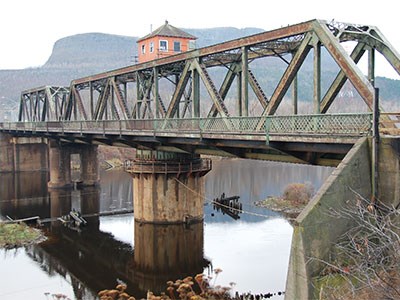The City of Thunder Bay is considering its legal options after reaching an impasse with CN Rail on reopening a vital dual purpose bridge between the city and Fort William First Nation.
The James Street swing bridge, owned by CN, was damaged by fire last October. It was immediately repaired by the railway and reopened to rail freight traffic within a week, but CN has kept the bridge closed to pedestrian and vehicle traffic.
The bridge is one of two access points between the city and the First Nation, but it is the shortest and most direct route.
The closure has caused frustration among residents and leadership of the Fort William First Nation who have concerns about emergency response times and the impact to its business district.
On July 15, CN said it would contribute 50 per cent of the cost of a short-term fix, up to $1.5 million, to reopen the bridge. After five hours of discussion between the city and CN on July 21, city council voted to reject CN’s offer and go the legal route.
In a July 22 statement, the city said the review will take “several months.”
The city is pointing to two agreements from 1905 and 1906 between the former Town of Fort William and the Grand Trunk Railway (a CN predecessor company) that stipulated the railway would be responsible to “maintain the bridge in perpetuity.”
“We have no alternative but to take the time for this in-depth legal review,” said Mayor Keith Hobbs in a statement. “We are frustrated on behalf of the residents of the City of Thunder Bay and Fort William First Nation who rely on the bridge to travel between our two communities for work, business and day-to-day activities; however, CN owns, operates and controls the bridge. They are solely responsible for the decision to keep the bridge closed or to reopen it to vehicles and pedestrians.”
“It presents a challenge to negotiate further with CN when it has taken the unilateral position that it is no longer responsible for the operation of the pedestrian and vehicular portions of the bridge under the 1906 agreement,” added city manager Tim Commisso.
“Let’s be clear – CN owns, operates, controls and maintains the bridge. CN is telling us it is unsafe – they are holding all the information regarding the structural condition of the bridge,” he said.
Just days before the fire, the city offered to work with CN on a structural assessment of the bridge, but received no reply from the railway.
“Even before the fire, the city asked to work together to assess the structural condition of the bridge,” said Commisso. “We have not heard back from CN on that offer.”




